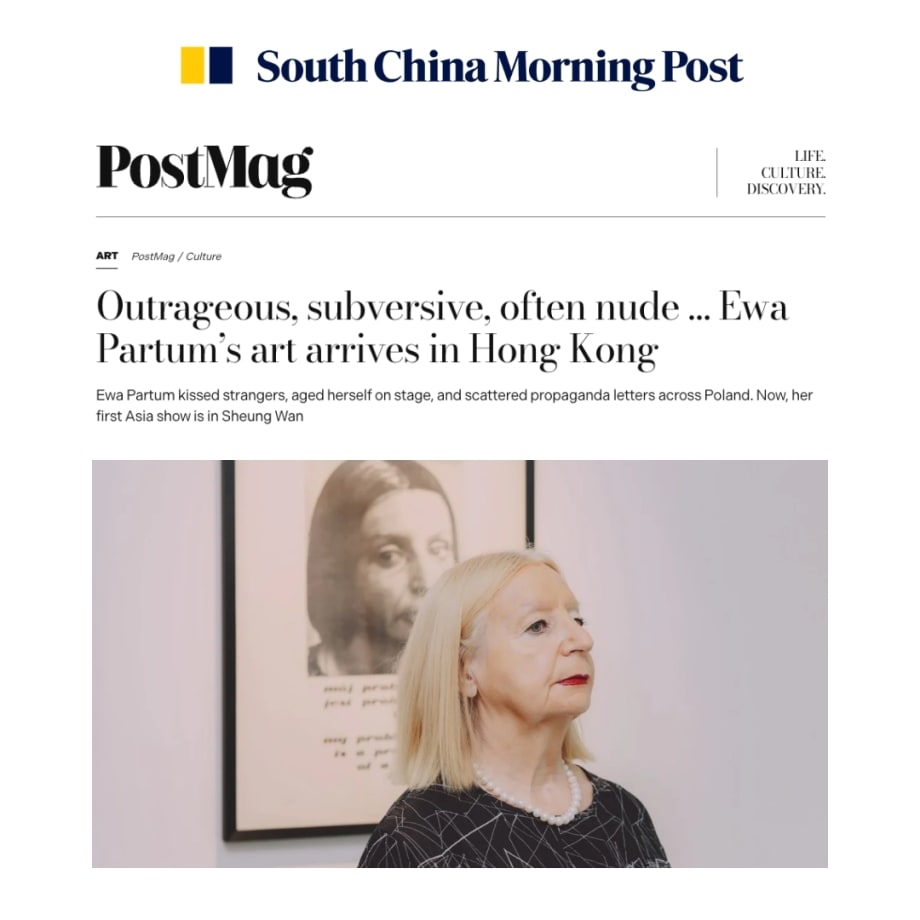Ewa Partum kissed strangers, aged herself on stage, and scattered propaganda letters across Poland. Now, her first Asia show is in Sheung Wan.
Ewa Partum would have you believe that she’s a stupid woman, or at least guilty of what 1980s Polish society deemed frivolous female behaviour. Dressed in nothing but high heels, red lipstick and a string of light bulbs, the artist would enact the trope of a silly drunken woman in front of a scandalised audience in 1981 – running around and dancing, flirting with men, giggling, pretending to stumble and fall.
An image from this performance was captured and set in a light box. It’s currently in the window of Double Q Gallery, in Sheung Wan, giving Hongkongers a taste of the artist’s pioneering practice for the exhibition “Ewa Partum: Conceptual Feminism”.
“I even convinced one of them to kiss me,” Partum, now 80, recalls at the opening of her Hong Kong show. “At that point I don’t think the audience could tell if it was a performance or real life.”
Partum’s artistic interventions in everyday life shaped her conceptual art practice. Interrogating gender norms and challenging patriarchal structures have always underpinned her work.
Part provocateur, part activist, but wholly artist and feminist, Partum has spent decades testing limits and confronting authority. “When I was in kindergarten, I convinced the other kids to rebel against the teacher,” she says. “If someone tells me to do something, I will do the exact opposite. It’s been like that from the beginning.”
This defiance persisted throughout college. Partum remembers that during her years as an art student at the Warsaw Academy of Fine Arts (1965-70), they were instructed to do exactly as the professor did. “We were even encouraged to copy them,” she says, “so, naturally, I wanted to do the opposite.”
Subversive, spirited and sharp, Partum has a commanding presence, accentuated by a short blonde bob and her signature red lipstick. Lipstick is another emblematic motif in her work, as seen in pieces such as My Touch is a Touch of a Woman (1971), part of her “Poems by Ewa” series, some of which are on view at the show.
For this series, which the artist classified as “conceptual poetry”, Partum would recite lines from poems, capturing the shape of her lips as she said the words with a red imprinted lipstick mark, often over printed text from the poem. “Everyone wore lipstick at the time, and you’d find the stain everywhere – on napkins, glass rims,” she says, noting how they were some of the only visible traces of a woman’s presence.
Partum was equally fixated on making her mark as both a woman and an artist. Educated in art during a time when painting was widely considered to have reached a “dead end”, she says she “was searching for a new language to create art”. Instead of finding one, she forged her own, using multiple art forms – performance, music, poetry, literature.
She fused performance, politics and text in Active Poetry (1971), taking individual letters cut from propaganda publications disseminated by the Polish socialist regime and scattering them across landscapes from urban underpasses to cliffsides and into the sea. The work was concerned with how meaning is constructed and unravelled, reflecting on language’s power and meaninglessness. Ironically, she bought these letters from a state-supported art shop.
At the time, Partum was reacting to a highly controlled political and social environment in 70s and 80s Poland. Although the country was not as isolated as some of its Eastern Bloc neighbours, information was still limited. “It was difficult to access what was happening in the world elsewhere, especially in terms of art,” says Partum. That lack of access was part of what compelled her to start her own gallery and build a network where artists could support one another. She founded Adres Gallery in 1972 and for five years organised exhibitions for many artists.
Poland was also experiencing growing social unrest, which was often met with harsh law enforcement. In an open, abandoned space ironically named Freedom Square, in the centre of the Polish city of Lodz, Partum installed boards she had collected from the transport department, such as traffic signs and warnings prohibiting dogs, swimming and parking, for a work titled The Legality of Space (1971). Among these, she included some of her own, featuring lines such as “permitting prohibited”. At the opening, she drove around the square with a megaphone, blasting these phrases. “There were just so many things that were not allowed,” she says, “so I decided to prohibit prohibiting.”
Nudity was a frequent and deliberate tool in Partum’s practice. In exposing herself, she exposed the insecurities within patriarchal structures that breed systemic disparities. Beyond providing shock value, the impact of it was intended to effect change.
The unequal and dismissive treatment of ageing women comes into focus in another seminal performance, My Problem is a Problem of a Woman (1979). Once again nude, Partum lay on a platform as make-up artists aged one half of her body in front of a live audience. “Women, especially artists, were consistently asked to give their age and men weren’t,” she says. “So at the end of this two-hour performance I declared I would continue to appear naked in public until women were given their rightful status in art history.”
At times it takes a seemingly absurd and outrageous gesture to generate momentum for a valid cause, and make a message hit home. While the promise of women gaining their rightful place in art history is yet to be fulfilled, the battle rages on with trailblazing icons such as Partum at the helm.


